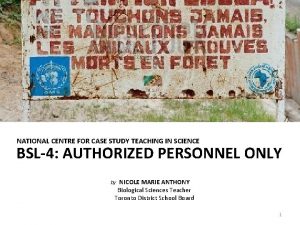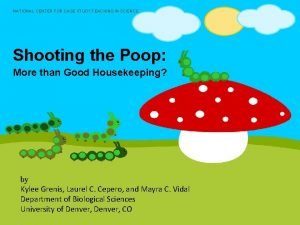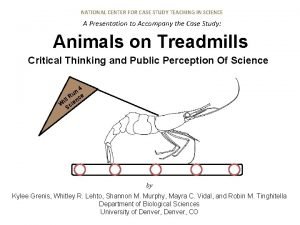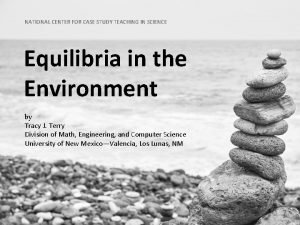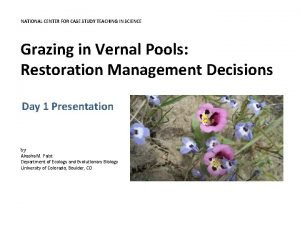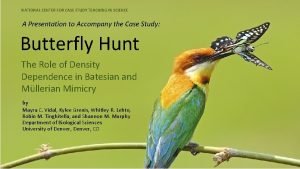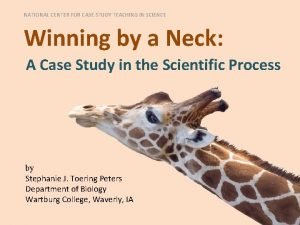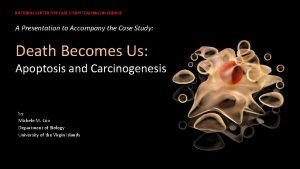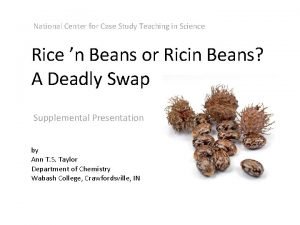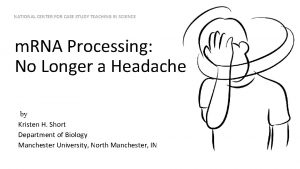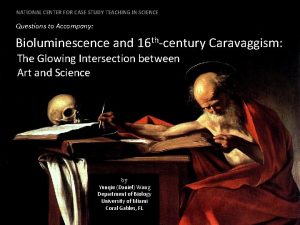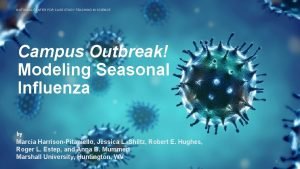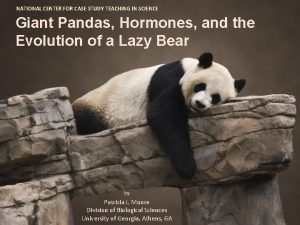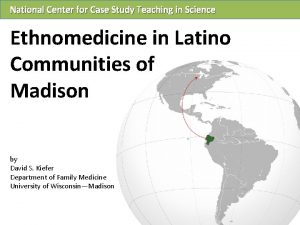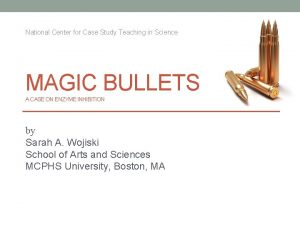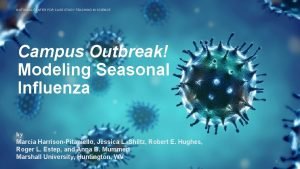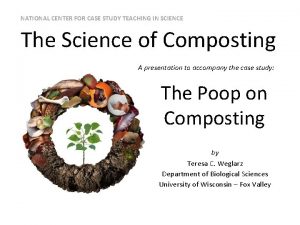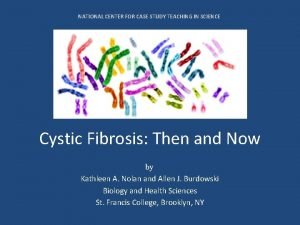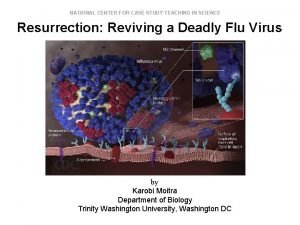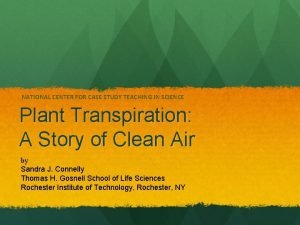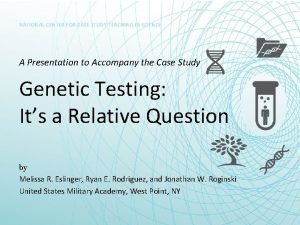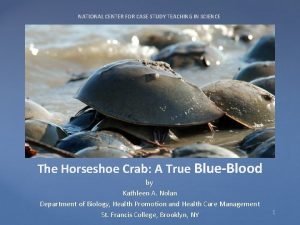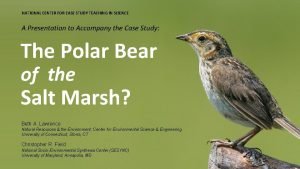NATIONAL CENTER FOR CASE STUDY TEACHING IN SCIENCE












































- Slides: 44

NATIONAL CENTER FOR CASE STUDY TEACHING IN SCIENCE Sex and the Komodo Dragon by Fiona Rawle 1, Marc Dryer 1, Joan Sharp 2 1 Department of Biology, University of Toronto at Mississauga 2 Department of Biology, Simon Fraser University

What is this animal? 2

Background • The Komodo dragon, Varanus komodoensis, is the world’s largest lizard species. – Males are up to 3 m in length, 90 kg in weight. – Females are up to 2 m and 70 kg. 3


5

6

7

8

9

10

11

How do Komodo dragons reproduce? 12

13

• Prior to 2006, it was thought that Komodo dragons could only reproduce sexually. • However, in 2006, an interesting thing happened at two different British zoos that housed Komodo dragons… 14

15

• 2 female Komodo dragons (at different UK zoos) laid viable eggs without fertilization (i. e. , no male sperm). – Flora: 11/25 (25 eggs laid, 11 were viable) – Sungai: 4/22 (22 eggs laid, 4 were viable) 16

• How is it possible that a female Komodo dragon was able to produce offspring without any male genetic contribution? Work as a group to come up with possible explanations. How could oogenesis be modified to produce diploid eggs that develop into a clutch of young dragons? 17

18

19

There are four possible explanations. 20

A diploid egg was produced by mitosis. 21

A haploid cell formed by meiosis I fused with the first polar body to yield a diploid egg. 22

A haploid cell formed by meiosis II fused with the second polar body to yield a diploid egg. 23

A haploid egg formed. The chromosomes in the egg underwent DNA replication. The sister chromatids separated during anaphase of mitosis, but then remained in a single cell as separate chromosomes to yield a diploid egg. 24

Genetic analysis of offspring Consider the genetic makeup of the offspring based on each possible explanation, and answer the following questions: 1. Would the offspring be genetically identical to their mother (i. e. , would they be a clone)? 2. Would the offspring be genetically identical to one another? 3. If the offspring are genetically different from one another and from their mother, how did the variation arise? 4. Would the offspring be homozygous/heterozygous at some/all loci? 25

CQ#1: If a diploid egg was produced by mitosis… Select the correct statement: A. The offspring would be genetically identical to their mother and to one another. B. The offspring would not be genetically identical to their mother but would be genetically identical to one another. C. The offspring and the mother would all be genetically different from one another. 26

CQ#2: If a diploid egg was produced by mitosis… Select the correct statement: A. The offspring would be homozygous at all genes. B. The offspring would be heterozygous at some genes. 27

CQ#3: If a haploid cell formed by meiosis I fused with the first polar body to yield a diploid egg… Select the correct statement: A. Cells formed in this way would be genetically identical to their mother and to one another. B. The resulting cells would not be genetically identical to their mother but would be genetically identical to one another. C. Cells formed in this way and the mother would all be genetically different from one another. 28

CQ#4: If a haploid cell formed by meiosis I fused with the first polar body to yield a diploid egg… Select the correct statement: A. The resulting cell would be homozygous at all genes. B. The resulting cell would be heterozygous at some genes. 29

CQ#5: If a haploid cell formed by meiosis II fused with the second polar body to yield a diploid egg… Select the correct statement: A. The offspring would be genetically identical to their mother and to one another. B. The offspring would not be genetically identical to their mother but would be genetically identical to one another. C. The offspring and the mother would all be genetically different from one another. 30

CQ#6: If a haploid cell formed by meiosis II fused with the second polar body to yield a diploid egg… Select the correct statement: A. The offspring would be homozygous at all genes. B. The offspring would be heterozygous at some genes. 31

IF… A haploid egg formed. The chromosomes in the egg underwent DNA replication. The sister chromatids separated during anaphase of mitosis but then remained in a single cell as separate chromosomes to yield a diploid egg. 32

CQ#7: Select the correct statement: A. The offspring would be genetically identical to their mother and to one another. B. The offspring would not be genetically identical to their mother but would be genetically identical to one another. C. The offspring and the mother would all be genetically different from one another. 33

CQ#8: Select the correct statement: A. The offspring would be homozygous at all genes. B. The offspring would be heterozygous at some genes. 34

• The DNA of the young dragons was analyzed. • All offspring were homozygous at all loci. • They were not identical clones of their mother: their genetic makeup was different from mum. • The offspring were not genetically identical to one other. What does this tell us about the mechanism of parthenogenesis in Komodo dragons? 35

CQ#9: How did parthenogenesis occur in the Komodo dragon? A. A diploid egg was produced by mitosis. B. A haploid cell formed by meiosis I fused with the first polar body to yield a diploid egg. C. A haploid cell formed by meiosis II fused with the second polar body to yield a diploid egg. D. A haploid egg formed. The chromosomes in the egg underwent DNA replication. The sister chromatids separated during anaphase of mitosis but then remained in a single cell as separate chromosomes to yield a diploid egg. 36

CQ#10: What sex were the parthenogenetic offspring? A. All offspring were male. B. All offspring were female. C. The offspring were half male, half female. 37

• While mammals have an XY system for sex determination, many reptiles (including Komodo dragons) have a ZW system for sex determination. – The Z chromosome is large and carries many genes (like the X chromosome of mammals). – The W chromosome is small, with few genes (like the Y chromosome of mammals). • In the ZW system, ZW are females and ZZ are males. 38

Birds also have ZW sex determination. Karyotype of female red-winged blackbird: Karyotype of male oriole: 39

CQ#11: What sex were the parthenogenetic offspring? A. All offspring were male. B. All offspring were female. C. The offspring were half male, half female. 40

• Many of the eggs produced by parthenogenesis did not develop to hatching. – Flora: Of 25 eggs laid, only 11 were viable. – Sungai: Of 22 eggs laid, only 4 were viable. • Why were so many eggs non-viable? Discuss in your groups. 41

• One of the female Komodo Dragons later reproduced sexually. REPRODUCTIVE PLASTICITY • Female Komodo dragons may switch between asexual and sexual reproduction, depending on the availability of a mate. 42

• What is the adaptive value of reproductive plasticity to a large (and thus scarce) lizard with ZW/ZZ sex determination that lives on a major archipelago? Discuss in your groups how reproductive plasticity might be adaptive for Komodo dragons. 43

Image Credits Slide 1: Varanus komodoensis by Dezidor, https: //commons. wikimedia. org/wiki/File: Varanus_komodoensis_2. jpg , CC BY 3. 0. Slide 2: Young Komodo dragon feeding at a water buffalo corpse on Rinca, by Mats Stafseng Einarsen, http: //commons. wikimedia. org/wiki/File%3 AKomodo_Dragon_Eating_Rinca. jpg, CC-BY-2. 5. Slide 4: Map showing Komodo dragon populations by Greg Holoboff. Slides 3, 5 -11, are all © Fletcher & Baylis, Wildside Photography, kfletcher@wildsidephotography. ca, http: //www. wildsidephotography. ca, used in accordance with terms of use: • Slide 3, Slide 5: Komodo dragon resting, http: //www. arkive. org/komodo-dragon/varanus-komodoensis/image-G 23057. html • Slide 6: Young Komodo dragon climbing tree to escape predation by larger dragons, http: //www. arkive. org/komodo-dragon/varanus-komodoensis/image-G 23059. html • Slide 7: Hind leg of a large Komodo dragon, http: //www. arkive. org/komodo-dragon/varanus-komodoensis/image-G 23056. html • Slide 8: Young Komodo dragon, http: //www. arkive. org/komodo-dragon/varanus-komodoensis/image-G 23058. html • Slide 9: 4 Komodo dragons feeding on a Timor deer, http: //www. arkive. org/komodo-dragon/varanus-komodoensis/image-G 23061. html • Slide 10: 2 Komodo dragons feeding on a Timor deer, http: //www. arkive. org/komodo-dragon/varanus-komodoensis/image-G 23060. html • Slide 11: Komodo dragon feeding on a Timor deer, http: //www. arkive. org/komodo-dragon/varanus-komodoensis/image-G 23062. html Slides 13, 16, 35, 41, 42, 43: Komodo dragon hatchling, by Frank Peters, https: //www. flickr. com/photos/fwp/35230564, CC BY-NC-ND 2. 0 Slide 15: Low resolution screenshot of BBC News page Wednesday, 20 December 2006, 18: 03 GMT, http: //news. bbc. co. uk/2/hi/science/nature/6196225. stm. Slide 18: Diagram of oogenesis by Greg Holoboff. Slide 19: Low resolution screenshot of Watts et al. , 2006, “Parthenogenesis in Komodo dragons, ” Nature 444: 1021 -1022. Slide 39: Hobart HH et al. 1982. Karyotypes of six species of North American Blackbirds (Icteridae: Passeriformes) The Auk. 99: 514 -518. https: //sora. unm. edu/sites/default/files/journals/auk/v 099 n 03/p 0514 -p 0518. pdf 44
 National center for case study teaching in science
National center for case study teaching in science National center for case study teaching in science
National center for case study teaching in science National center for case study teaching in science
National center for case study teaching in science National center for case study teaching in science answers
National center for case study teaching in science answers National center for case study teaching in science
National center for case study teaching in science National center for case study teaching in science
National center for case study teaching in science National center for case study teaching in science
National center for case study teaching in science Best case worst case average case
Best case worst case average case Project failure case study
Project failure case study Geography is my favourite at school
Geography is my favourite at school Difference between micro teaching and traditional teaching
Difference between micro teaching and traditional teaching Fspos
Fspos Typiska drag för en novell
Typiska drag för en novell Tack för att ni lyssnade bild
Tack för att ni lyssnade bild Returpilarna
Returpilarna Varför kallas perioden 1918-1939 för mellankrigstiden?
Varför kallas perioden 1918-1939 för mellankrigstiden? En lathund för arbete med kontinuitetshantering
En lathund för arbete med kontinuitetshantering Adressändring ideell förening
Adressändring ideell förening Vilotidsbok
Vilotidsbok A gastrica
A gastrica Densitet vatten
Densitet vatten Datorkunskap för nybörjare
Datorkunskap för nybörjare Stig kerman
Stig kerman Att skriva en debattartikel
Att skriva en debattartikel Delegerande ledarskap
Delegerande ledarskap Nyckelkompetenser för livslångt lärande
Nyckelkompetenser för livslångt lärande Påbyggnader för flakfordon
Påbyggnader för flakfordon Arkimedes princip formel
Arkimedes princip formel Offentlig förvaltning
Offentlig förvaltning Lyckans minut erik lindorm analys
Lyckans minut erik lindorm analys Presentera för publik crossboss
Presentera för publik crossboss Jiddisch
Jiddisch Vem räknas som jude
Vem räknas som jude Klassificeringsstruktur för kommunala verksamheter
Klassificeringsstruktur för kommunala verksamheter Mjälthilus
Mjälthilus Claes martinsson
Claes martinsson Cks
Cks Byggprocessen steg för steg
Byggprocessen steg för steg Bra mat för unga idrottare
Bra mat för unga idrottare Verktyg för automatisering av utbetalningar
Verktyg för automatisering av utbetalningar Rutin för avvikelsehantering
Rutin för avvikelsehantering Smärtskolan kunskap för livet
Smärtskolan kunskap för livet Ministerstyre för och nackdelar
Ministerstyre för och nackdelar Tack för att ni har lyssnat
Tack för att ni har lyssnat Referatmarkeringar
Referatmarkeringar
